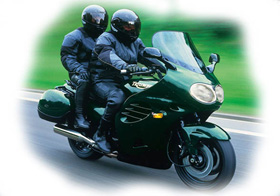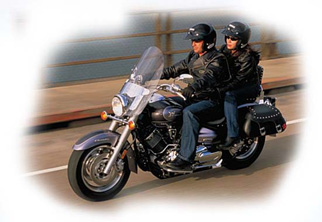Two Up Riding
Taking a passenger on the back of your motorcycle can be a very pleasant experience or a terrifying ordeal, depending on experience, yours as well as your passenger’s.
The motorcycle:
Having a passenger on the back of your bike, will affect the way the motorcycle handles. Even a small person will make a difference in how a motorcycle handles, because that is a significant portion of the bikes weight (could be as much as 20% to 30%).
Adding any significant amount of weight will affect how a motorcycle:
- Turns – it will require more effort to get the motorcycle to turn.
- Accelerates – getting up to speed will require more time as well as distance
- Stops – if a motorcycle has more weight, physics dictates that it will require a longer distance to stop from any speed.
The Rider:
Before taking a passenger on your motorcycle, it is a good idea to practice excises such as turning, accelerating and braking (with a passenger), in a controlled environment such as a parking lot; before venturing out into traffic. In so doing the rider can get an indication of how the motorcycle will behave with the extra weight.
The Passenger:
A passenger, who has never been on a motorcycle before, might not know exactly what to do; thus it is up to the rider to educate them. What does a passenger have to know? Though a passenger doesn’t have much to do on the back of a motorcycle, there are a few things that they should do to make the ride safer and more enjoyable.
- A motorcycle must lean to make turns, so the passenger should lean with the rider and the motorcycle.
- The passenger should pay attention as the motorcycle accelerates, turns and stops under regular conditions; as well as if the rider has to accelerate, turn or brake aggressively
- Sit as still as possible while the motorcycle is stopped to avoid loss of balance.
Communication:
One of the most important aspects of riding with a passenger is communication (before, during as well as after the ride). Before the ride it is important to make sure that the passenger knows what to expect and what they should do during the ride. As I said before if this is their first time on a motorcycle they probably will not know what to expect and could do something that can upset the motorcycle’s balance or steering. It is also a good idea to discuss a few simple signals that the rider and passenger can use (i.e. stops for washroom/ rest/ food breaks, slowing down etc.) during the ride.
It also is important that the passenger let the rider know when they are getting on or off the motorcycle, so that the rider can brace them self and the motorcycle to avoid loss of balance. A common mistake that inexperienced passengers tend to make is that they put all their weight on one foot peg as they are getting on the motorcycle, which can cause the bike to tip over. What the passenger should do is slide their leg over the motorcycle first (if possible), and then put their feet on the foot- pegs. In so doing the passenger’s weight does not upset the motorcycle when they are getting on or off.
After the ride it is a good idea for the passenger and rider to have a discussion about how the ride went; was the passenger comfortable with the ride (the speed, the distance/ time between stops, the seat, their overall comfort level etc.) Most riders can go a lot further between stops than their passengers because they are usually more used to riding, as well as the rider seat is usually more comfortable than the diminutive passenger seats offered on a lot of current bikes (some touring/ cruising bikes excluded).
Safety Gear:
Riding on a motorcycle has some inherent risks that one would not experience while driving in a car, since a car has a steel cage, seat belts, air bags etc. This makes it important that both rider and passenger wear the appropriate gear that will protect them in case of a mishap. It never ceases to amaze me how many riders I see on the road wearing shorts, t-shirt and runners. How much protection would they have if something were to happen? The answer would invariable be, “Not much at all!” If the rider is not wearing the proper gear then what are the chances that the passenger will be? Slim to none!
I also see cases where the rider is wearing their safety gear, while the passenger is wearing a “safety” tank-top, shorts and flip-flops. If there were an incident the rider would probably escape with minor injuries, while the passenger more than likely would need to take a trip to a hospital for road-rash and other serious injuries.

As a rider I never get on my motorcycle without my safety gear, and I absolutely will not take a passenger if they do not have the proper gear as well! My passenger’s safety (as well as mine) is in my hands, the risk of myself and them getting injured is one that I definitely want to minimize.
One last thing that I want to mention, if you are going to take someone for a ride it is a good idea to do so with safety in mind. This is not the time to show-off or to scare them.Showing of is probably the quickest way to go from “Hero” to “Zero”, not to mention make enemies of that person and their family.
“Bring your passengers back safe and sound!”





